Deep research on Proto-danksharding and its operating principles
Research on Proto-danksharding and how it works.Author: Christine Kim, Vice President of Research at Galaxy Digital; Translation: Blockingxiaozou
After the Ethereum merge and the Shanghai upgrade, Ethereum has successfully transitioned from proof of work to proof of stake consensus protocol. The next major event on Ethereum’s development roadmap is the Ethereum Improvement Proposal (EIP) 4844, called proto-danksharding. The code update is designed to improve the scalability of rollups running on Ethereum. EIP 4844 is named after Ethereum core developers “Protolambda” and Dankrad Feist and introduces a new transaction type called blobs, increases the data and storage requirements of Ethereum blocks, and creates a new fee market that separates blob from regular transactions.
The rollup protocol relies on Ethereum layer 1 blockchain to obtain data availability (DA) – the ability to widely propagate and temporarily store bulk transaction data. Typically, smart-contract based rollups that rely on Ethereum to obtain DA also rely on Ethereum for transaction settlement (verification). These rollups are specialized for reading data from DA layers such as Ethereum and executing efficient transactions and smart-contract code. Rollups built on top of Ethereum rely on including bulk transaction data in Ethereum blocks to achieve transaction finality. The sequencer batch and compresses user transactions in an economically efficient manner to submit to the DA layer.
Typically, the cost of publishing large amounts of data to Ethereum is high, in part because the network stores the data as part of transaction history in a field called “CALLDATA.” With EIP 4844, an additional 512KB or 768KB data space will be created for rollups per block. Ethereum core developers are weighing how much extra space should be created for blob transactions. Importantly, data published to this space will be stored for approximately three weeks. As the data verified by blob transactions is stored for a short period of time and the blob transaction fee market is independent of other types of transactions, the cost of publishing data to Ethereum’s rollup is theoretically significantly reduced. Over time, developers plan to introduce data sampling techniques to make blob data not require full download for Ethereum full nodes to verify, further reducing the cost of rollups. Proto-danksharding is the vanguard force and “prototype” for achieving full danksharding, enabling Ethereum nodes to determine the full availability of blobs by downloading only blob data blocks.
- 101 Key Points About Ethereum
- Exclusive Interview with Polygon zkEVM: Decentralized Order Book on Layer2 More Important than Regulatory Issues Facing Ethereum
- After Hong Kong’s new encryption policy, banks are not cooperating with account opening. Regulatory agencies are pressuring multiple banks.
This article will delve into the operation of EIP 4844, the limitations of proto-danksharding, the plan for EIP 4844 to evolve towards full danksharding, and the direct benefits and related considerations for end users and decentralized application (dApp) developers if the code update is implemented according to the plan in the fall of 2023. Given that the focus of proto-danksharding is to support the 2nd layer rollup ecosystem and modular expansion of Ethereum, the implementation of code updates in the next Ethereum upgrade will become an important experimental field for the large-scale application of modular blockchain theory on one of the world’s largest public blockchains.
1. Background
EIP 4844 is considered as Ethereum’s scalability upgrade. However, it is worth noting that the code update does not substantially increase or improve Ethereum’s own transaction capabilities. Proto-danksharding reduces the cost of publishing large amounts of data to Ethereum, thus reducing the operating costs of rollups. The reason why EIP 4844 is considered an improvement in Ethereum’s scalability is that it makes 2nd layer networks running on top of Ethereum more cost-effective, but the code update does not improve Ethereum’s general blockchain scalability as a platform for transactions and smart contract code execution.
Over the past four years, transaction activity on Ethereum rollups such as Arbitrum, Optimism, StarkNet, zkSync, and Polygon zkEVM has been increasing. L2Beat.com estimates that the total sum of transactions per second (TPS) implemented on all 2nd layer networks is 3.8 times the daily TPS of Ethereum.
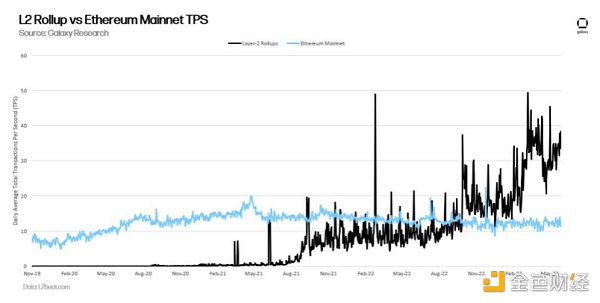
According to Blockworks Research data provided by Dune Analytics, rollups save end users and dApp developers over 99% of gas fees compared to directly deploying code and transactions to Ethereum.
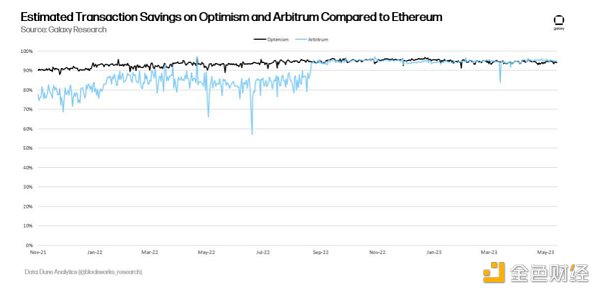
As of June 13, 2023, the cost of sending transactions on the two most popular Ethereum rollups (Optimism and Arbitrum) is approximately $0.03 to $0.05 per transaction. However, in cases of frequent on-chain activity and network congestion, costs can sometimes soar to over $1.
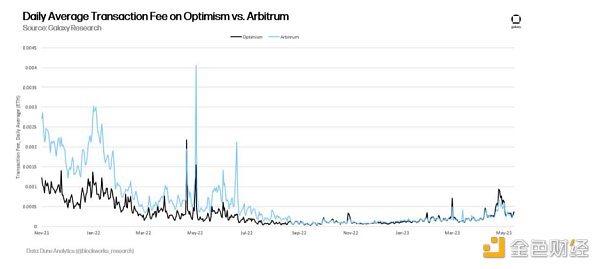
The goal of EIP 4844 is to lower the cost of rollups by introducing a new transaction type called binary large object (blob). Here is a step-by-step explanation of the blob transaction lifecycle defined by EIP 4844:
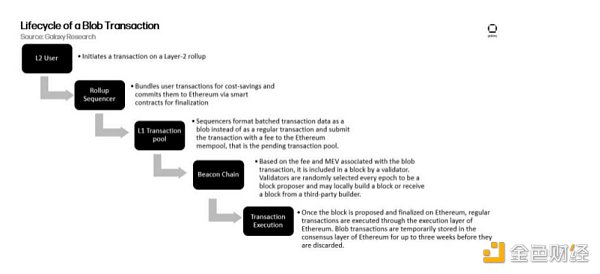
EIP 4844 will not affect the way regular transactions submitted to the Ethereum memory pool are included in blocks, nor will it affect the fee market that determines Ethereum block space pricing, but EIP 4844 will indeed increase the storage requirements of Ethereum blocks. The additional data space is used to attach blob transactions to blocks. Blobs are like dump trucks that can be attached to Ethereum blocks to process regular transactions without affecting or squeezing out existing block space. The blob block space will be auctioned off based on its own fee market, mimicking the fee market design of EIP 1559. Initially, blob transactions are almost costless. After that, the cost of blob transactions will increase by 12.5% for each block that confirms more than half of the blob block space (at least 256KB). If the blob block space is not fully utilized, i.e., if the filled block space is less than 50%, the cost of blobs per block will be reduced by 12.5%.
Blob transactions will not be stored on Ethereum indefinitely, but will be stored on Ethereum’s consensus layer (CL) beacon chain and deleted from CL nodes after three weeks. Proto-danksharding will support up to four blobs per block, with each blob containing up to 128KB of additional data. The limit of 512KB of blob space per block may be adjusted based on ongoing EIP 4844 testing. Developers are actively discussing the possibility of increasing the maximum limit of blobs from four to six. Each blob is an opportunity for a rollup sorter to confirm a batch of transactions to Ethereum. Ethereum produces approximately 7,094 blocks per day, and assuming a limit of up to four blobs per block after EIP 4484, up to 28,376 blobs can be processed per day. (This is theoretically the maximum, but in practice, it may never be reached because of the dynamic cost of blobs. It is very expensive for a sorter to process the maximum number of blobs per block continuously.)
In the past six months, the sorter running on the Ethereum rollup that ranks second in transaction activity has submitted about 3,126 transaction packets to Ethereum per day.
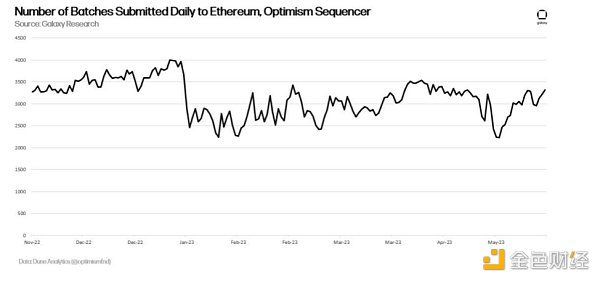
The transaction load confirmed by Arbitrum is about twice that of Optimism, and like Optimism, it also relies on sorters to publish data to Ethereum via CALLDATA to complete transactions. Popular rollups on Ethereum include but are not limited to Polygon zkEVM, zkSync and StarkNet. On Optimism, over 90% of the fees come from the first layer CALLDATA fees.

The purpose of introducing a dedicated data storage space (no matter how small the space is at the beginning) is to reduce the cost of using Ethereum as the DA layer for all Ethereum rollups. Rollup developers estimate conservatively that rollup fees will decrease by 100% to 900% after EIP 4844 is activated. However, these estimates may change depending on the increase in rollup adoption and activity in the months before and after proto-danksharding is launched.
Although the cost of blob transactions may be cheaper than regular transactions at the time of EIP 4844 activation, if the number of rollups running on Ethereum increases, the cost of blob transactions may increase rapidly. In addition, although each blob means that a sorter has the opportunity to publish up to 128KB of data, for rollup sorters, single blobs can contain data from multiple rollups through coordination. Ethereum developers are aware that since the number of blobs per block is limited and a single transaction package may not fully utilize all 128KB of data space available for each blob transaction, there may be a secondary market for blob pricing. Although preventing the emergence of off-chain secondary markets is a priority (rather than preventing this possibility by introducing higher-level protocol complexity), developers are currently “waiting and seeing” on EIP 4844 and plan to further optimize EIP 4844 in the future.
Proto-danksharding lays the foundation for introducing more advanced technologies that can further reduce blob costs without increasing node computational load. The complete vision of blob is “full danksharding”, increasing the maximum number of blobs per block from 4 to 64.
(1) Full Danksharding
Four blobs can increase the size of the Ethereum block by 512KB. Six blobs can increase the size of the Ethereum block by 768KB. As mentioned earlier, the additional block space is strictly dedicated to blob transactions and does not permanently store data like regular block space. The complete vision of EIP 4844 is to introduce up to 64 blobs to Ethereum without significantly increasing node computational load for block verification. To achieve full danksharding, Ethereum needs to implement two technologies: data availability sampling (DAS) and erasure encoding.
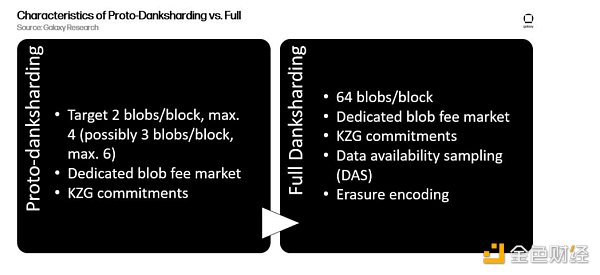
· Data Availability Sampling (DAS)
When verifying Layer 2 rollup transactions, the goal of DAS is to ensure that all data packed by the sorter has been published to the chain. Random full nodes select a piece of data to download from a blob and generate a data availability proof. The more times a full node performs data sampling, the more deterministic the probability of obtaining all data from the sorter without retaining important data. For nodes, the data sampling process involves less computation than downloading the entire blob data, but can theoretically ensure data availability. Like proto-danksharding, conducting blob data sampling under complete danksharding will ensure that the transactions from the sorter have been verified and published to the chain for any user or network stakeholder to evaluate. Then, users and stakeholders will check these transactions over a period of time, confirming that they have been completed on DA layers such as Ethereum and building new batches of transactions on the basis of the previous batch of transactions.
Through DAS, Ethereum developers believe that they will be able to increase the number of blobs and the amount of data published to Ethereum without increasing the computational load on nodes. In addition, developers also plan to further reduce the computational load on nodes by implementing suggestions such as history expiry in future upgrades. As Dankrad Feist, an Ethereum researcher, put it, over time, Ethereum will be used as “a public bulletin board rather than an archival system,” and the responsibility of maintaining a complete copy of transaction history will be handed over to network stakeholders who frequently use this data, such as Layer 2 rollup and blockchain infrastructure companies like Infura, Alchemy, and Blockdaemon. Introducing blobs through EIP 4844 is an early example that tells us that one day all transactions may be stored on Ethereum.
· Erasure Encoding
Erasure encoding is a technique to improve data sampling capabilities. If a malicious sorter withholds a small portion of block data (such as between 1% and 49% of blob data), transaction sampling may result in some sample proofs being returned as correct values rather than incorrect values. Erasure encoding ensures that validating at least half of the data in a blob can reconstruct the rest of the blob. This technique is only effective when data is represented as a polynomial (an expression consisting of two or more algebraic terms). The most common form of erasure encoding is based on Reed-Solomon codes (RS), which is an advanced mathematical formula that can solve missing data based on enough known data. Intuitively, sampling alone may not effectively guarantee data availability for large amounts of data, especially under the assumption that a data block is withheld by a malicious sorter. Erasure encoding introduces data redundancy to blobs, so a malicious sorter must withhold a significantly larger share of blob data to successfully retain any amount of data.
The combination of DAS and erasure coding technology is the technical support behind fully sharded Ethereum. These technologies are the same as those behind certain layer-2 solutions such as Polygon Avail and Celestia. In many ways, the vision of supporting modular blockchain computations (which other blockchain projects are testing on a smaller scale) will be tested on Ethereum through proto-danksharding, and officially tested through fully sharded Ethereum.
(2) KZG Commitments
Prior to implementing DAS and erasure coding technology on Ethereum, fully sharded Ethereum needs to implement KZG commitments. Kate Zaverucha Goldberg (KZG) commitments are a zero-knowledge (ZK) proof system that can evaluate a polynomial without revealing the entire polynomial. If large data objects like blobs are first represented as polynomials, then they can be efficiently operated and proven by computers. EIP 4844 emphasizes the introduction of KZG commitments as part of the blob verification and proof generation process. For Layer 2 rollups that rely on ZK proofs, KZG commitments can represent the computation of transactions and the rollup protocol state. In the context of EIP 4844, KZG commitments can check the properties of a blob without reading the entire blob transaction.
(3) KZG Ceremony
The KZG commitment scheme used to verify blobs relies on a secret value generated once by a trusted setup. Some encryption protocols, such as Zcash, Tornado Cash, and Filecoin, rely on trusted setups to securely generate a secret value for on-chain computations. The trusted setup ceremony for EIP 4844 began in January 2023 and has received nearly 100,000 contributions from the Ethereum community. Background: A trusted setup ceremony is a one-time process used to generate data for an encryption protocol from contributions from multiple parties. The goal of combining entropy from multiple party contributions in a trusted setup ceremony is to generate a secret value that is almost impossible to reproduce or guess. It is critical that the final value created by the trusted setup ceremony cannot be reproduced.
The KZG ceremony will open for contributions in May 2023 and may close in the months leading up to the activation of EIP 4844 on the mainnet. Most ceremony contributions are provided through publicly accessible websites funded by the Ethereum Foundation, where users connect with their Ethereum address and run the calculation automatically, with randomness helping to increase secret value security. Additionally, there are other contributions created through unique events involving music, large groups, animals, and even a pinball machine.
2. Benefits and Impacts
Introducing blob on Ethereum and introducing SegWit on Bitcoin have many similarities. Both code updates introduced modifications to the way data is stored on the chain, resulting in an increase in effective block size and support for Layer 2 protocols. However, one of the main differences between SegWit and EIP 4844 is the expected long-term impact of these code updates. While SegWit aimed to address immediate vulnerabilities in the protocol code and support the creation of the Lightning Network in the short term, the motivation behind EIP 4844 is to lay the foundation for further scaling optimizations (such as DAS) and eventually become the optimized DA layer. Proto-danksharding enhances Ethereum’s ability to support L2 rollups and service rollup sorters, while encouraging end-users to transact on rollups instead of directly on Ethereum.
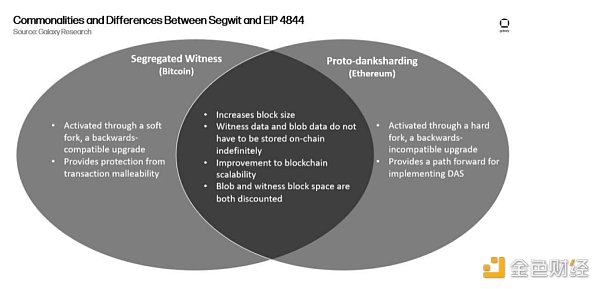
Compared to data that fills regular Ethereum block space, there are several key differentiating attributes of blob block space. First, because of its transience, blob transactions are expected to have lower gas fees than regular transactions. Second, while dapps, developers, and end-users can easily retrieve regular transaction data stored in Ethereum blocks and interact with smart contracts through the Ethereum Virtual Machine (EVM) (the execution environment of Ethereum), blob data will be relatively difficult to retrieve and interact with. Blob data will be stored in Ethereum’s CL, and thus, can only be used for a limited set of operations, namely transaction confirmation and finalization.

Looking ahead, one of the metrics to watch for the impact of EIP 4844 is the reduction in rollup costs. Using the CALLDATA field in Ethereum transactions to publish batch transaction data to Ethereum consumes 16 gas per byte. On the other hand, the cost of blob was initially essentially free and then gradually increased. In addition to the cost of blob, another metric worth noting regarding the impact of EIP 4844 is the data propagation load on full nodes. The size of a regular Ethereum transaction is less than 1KB, which means that Ethereum nodes can easily propagate this data without using high-bandwidth. However, the size of a single blob transaction can reach 128KB, which means that blob requires more computation for nodes to propagate.
The following table summarizes several key metrics related to assessing the impact of EIP 4844:

Similar to the Taproot upgrade of Bitcoin, it’s difficult to predict how blob transactions and blob block space will be used, aside from the expected use case of processing Layer 2 rollup transactions. Given that the adoption of L2 rollup has been unstable and susceptible to extreme fluctuations over the past few years, it’s difficult to accurately predict how much EIP 4844 will reduce L2 rollup costs. L2 rollup itself has also undergone significant upgrades and improvements over the past few years. In August of last year, Arbitrum Nitro completed the Nitro upgrade, claiming that the upgrade increased transaction throughput by over 7 times. Optimism completed the Bedrock upgrade on June 6, 2023, with the goal of reducing costs for end users by 10% and introducing several other user experience-related improvements.
As the capacity and functionality of rollups built on top of Ethereum continue to evolve, it’s difficult to accurately predict how much EIP 4844 will affect the costs and activity of Layer 2 rollup. In any case, the expected benefits of EIP 4844 for Ethereum are as follows:
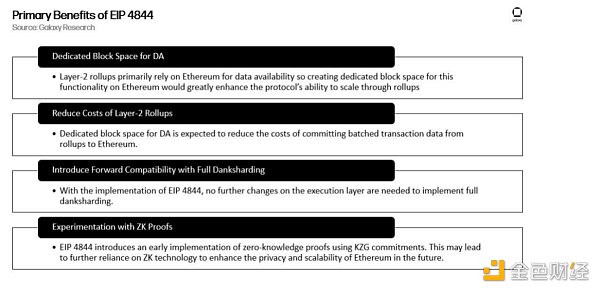
3. Relevant Considerations
The idea for EIP 4844 was proposed at the Ethereum ETHDenver conference in February 2022. The first EIP 4844 testnet launched in August 2022. Since then, the Ethereum client team has iterated on the code and released four additional testnets. As developers work to release their sixth dedicated testnet, there are clear concerns and outstanding issues around the implementation of EIP 4844. As of May 2023, ongoing discussions around the implementation of EIP 4844 include:
· De-SSZify EIP 4844 Spec: Developers have been discussing the best way to serialize the new blob transaction type for months. Initially, developers were inclined to introduce the SSZ format to the EL layer through blob transactions in early iterations. Unlike CL, Ethereum EL traditionally relies on the RLP serialization format. Ultimately, developers plan to upgrade all transaction types from RLP to SSZ format, but given that the path from RLP to SSZ is still unclear and certainly not ready to be implemented in the Cancun upgrade, developers decided to remove SSZ from EIP 4844, at least from the EL side.
· KZG Commitment Library: The KZG commitment library has been a topic of interest for many people. These libraries provide implementations of KZG functions defined by the EIP 4844 polynomial commitment specification. However, some key aspects of the library are undergoing updates, which makes it difficult for Ethereum client teams to use these libraries and integrate them into their codebase.
· Testing via Geth (EL) client: The EIP 4844 tests are based on a forked version of the Geth (EL) client. Developers are actively working to migrate the EIP 4844 tests to the Geth main codebase.
· MEV-Boost testing: MEV builders and relayers have yet to begin full-scale testing of blob transactions. Developers are working hard to incorporate MEV-Boost-related software testing into the EIP 4844 development process as early as possible.
· Blob fee market design: The Blob fee market is designed based on EIP 1559. EIP 1559 increases the gas cost of transactions in both directions by 12.5% based on block space capacity. However, the implementation of EIP 1559 on Ethereum has led to highly volatile block sizes. To avoid blob block space being used to produce the same results, developers are considering alternative parameters for blob gas fees.
· Decoupling blob from block propagation: Blob is the heavier data propagated between Ethereum nodes. As a result, developers are exploring strategies to decouple blob propagation from block propagation so that transaction processing speed is not slowed down by blob activity.
· Blob transaction mempool during chain reorg: During chain reorg, regular transactions are reinserted into blocks. Because blob is decoupled from block propagation, there is no direct way to ensure that all blobs in the mempool will be reconstructed after a reorg. Developers are considering how to handle blob transactions in the case of temporary chain splits.
· Handling blob transaction loss: Unlike transactions submitted to the mempool that can be easily cancelled by the user, blob transaction propagation is quite difficult and resource-intensive and should not be so easily cancelled or replaced after broadcast. Developers may impose penalties for behavior that renders blob transactions invalid after they are submitted to the mempool.
The next Ethereum upgrade, named Cancun on EL and Deneb on CL based on scope, is tentatively scheduled to activate EIP 4844 on the Ethereum mainnet in the fall or winter of 2023. Any Ethereum upgrade requires extensive testing and coordination. Since the Ethereum merge, the Ethereum protocol has expanded and become more complex. The following is a description of the Ethereum protocol sections and related software that must be updated to prepare for the Cancun upgrade.

In addition to EIP 4844, the following four EIPs will be activated in the Cancun upgrade:
· EIP 6780, SELFDESTRUCT in the same transaction only: This EIP changes the functionality of the SELFDESTRUCT opcode, allowing it to be deprecated with minimal impact on existing smart contracts.
· EIP 1153, Transient Storage Opcodes: This EIP introduces transient storage opcodes, which behave the same as storage opcodes except that the data is discarded after each transaction, resulting in simpler smart contract design and gas savings for end-users.
· EIP 4788, Beacon Chain Block Root in EVM: The beacon chain block root is made public in the EL block header, allowing for CL state proofs in the EVM. This will improve trust assumptions for staking pools, re-staking structures, smart contract bridges, MEV protocols, etc.
· EIP 5656, Memory Copying Instruction: Introduces a new EVM instruction for copying a memory area, providing an efficient means of building data structures and deploying computationally heavy operations on Ethereum.
Similar to the Shanghai upgrade process, Ethereum core developers are prioritizing the activation of EIP 4844 as the primary code update to enter the Cancun upgrade. Therefore, due to the complexity of EIP 4844 and the significant amount of time and work required to thoroughly test the code update, developers have decided to reject all other Cancun upgrade EIP proposals except for the four listed above. The aim is to keep the Cancun upgrade as streamlined as possible, including only those EIPs with the lowest complexity or highest urgency. The urgency priority of EIP 4844 over other EIPs was canceled shortly after the merge upgrade, a controversial topic that highlights the need for improvements beyond Ethereum’s scalability.
Demand for EIP 4844
The EIP 4844 upgrade will reduce the cost for end-users to send transactions and deploy smart contracts on rollups. Although several rounds of transaction activity peaks have resulted in transaction fees increasing to over $1, since January 2022, rollup and Ethereum fees have been relatively low. As of June 14, 2023, the cost of transferring ETH on most L2 rollups is often less than $0.20.
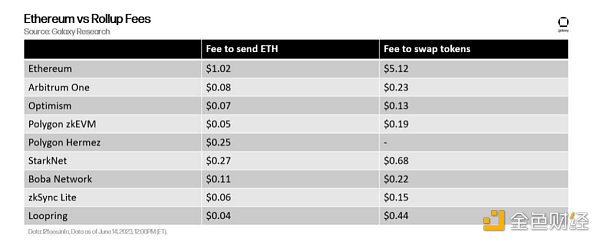
Without high fees or transaction congestion, economic activity on Ethereum almost loses its financial incentive to turn to rollups. Based on Ethereum’s 8-year on-chain activity history, fee escalation is only a matter of time, emphasizing the need for Ethereum’s scaling solutions. However, in the short term, without a catalytic event or narrative-driven on-chain activity, EIP 4844 is unlikely to further reduce Ethereum fees.
Even with the economic catalysts that have indeed emerged to drive Ethereum and Ethereum-based dapps’ economic activity and growth before and after the activation of EIP 4844 this year, it is unclear whether the transaction activity that inundates Ethereum will have a meaningful amount of transfer to take advantage of the cost-saving benefits. While rollups are cheaper to use than Ethereum (even much cheaper today), they are still in their early stages of development and cannot provide users with the same level of security, usability, or decentralization as Ethereum. Most of the rollups on Ethereum today are unlikely to ever reach the level of L1 because the innovation of rollup technology and new rollup designs will make current rollups obsolete.
Ethereum is the world’s most secure and decentralized general-purpose blockchain, supporting thousands of dapps that can also be interoperable and compositional through standards like ERC-20 and ERC-721. Although rollup developers are designing proof systems that support minimal trust bridging and working to enhance client diversity to eliminate reliance on multi-sig wallets, these efforts will take years to develop and deploy. At this stage of development, rollups are competing with replaceable L1 blockchains that do not provide the same level of assurance for users and transaction activity as Ethereum in terms of network uptime, finality, or interoperability. Rollups today are not an attractive alternative to Ethereum.
Over time, rollups are expected to become more and more attractive, but before they can have a higher degree of decentralization, usability, and security, code updates like EIP 4844 are unlikely to single-handedly drive the adoption or activity of rollups. For most end-users of Ethereum, EIP 4844 has almost no impact on their usage experience. For the few end-users who are already using rollups or have turned to rollups because of proto-danksharding, the impact result will be lower fees without meaningful improvements to rollup security or interoperability.
It can be said that migrating the sorter from using CALLDATA to blob data will release regular block space for Ethereum end users. In the past three years, only an average of 2% of available block space has been used by L2 rollups. Therefore, the impact of rollups’ migration from using CALLDATA to blob data on available block space is small. Secondly, increased usage of rollups by Ethereum end users may lead to proportional increases in bridging activities, which may then offset the small decrease in sorter block space usage.

The Urgency of EIP 4844
In the past 12 months, the crypto industry has experienced a series of protocol failures, hack attacks, high-profile bankruptcies, and criminal lawsuits. More broadly, the macroeconomic conditions after the COVID-19 pandemic – rising inflation rates and interest rates in several countries (most notably the United States) – have also led to a general decline in economic activity in the crypto market and traditional financial markets. In addition, government agencies such as the US Securities and Exchange Commission (SEC) are increasingly scrutinizing the crypto industry, with targets being blockchain-based applications and services, where the most valuable and popular applications and services run on Ethereum. The following are the headlines of regulatory news related to the crypto industry since early 2023:
· In February of this year, the US Securities and Exchange Commission sued cryptocurrency exchange Kraken for selling unregistered securities through its staking service, resulting in their closure of staking services in the US.
· In March of this year, a member of the European Parliament (MEP) voted in favor of an anti-money laundering bill that requires DAOs, DeFi protocols, and NFT markets to perform the same due diligence on users as traditional banks and financial institutions.
· In the same month, the New York Attorney General (NYAG) filed a lawsuit against the cryptocurrency exchange KuCoin and listed ETH as a security in the same lawsuit.
· In April of this year, the US Treasury Department released a similar report confirming the need for decentralized financial protocols to comply with US anti-money laundering and sanctions laws.
· In June of this year, the US Securities and Exchange Commission sued Binance, the world’s largest cryptocurrency exchange, for violating federal securities laws.
In the same month, the US Commodity Futures Trading Commission (CFTC) won a lawsuit against decentralized autonomous organization (DAO) Ooki DAO for offering unregistered commodities.
During the cryptocurrency bear market and concerns about the global economic recession, legislators and regulators around the world continue to evaluate policies and rules that can affect the extent of Ethereum access and activity, and how much impact should be implemented. In order to realize the vision of Ethereum as a world computer, Ethereum core developers must not only work to mitigate centralization trends at the protocol level, but also at the application level, to enhance the quality of anti-censorship, which is very important.
In the past year, the Ethereum Foundation and other prominent Ethereum stakeholders have become increasingly concerned about the phenomenon of maximum extractable value (MEV) precisely because of the centralizing effect of MEV. In order to mitigate the negative externalities of MEV, Ethereum core developers have collaborated with Flashbots to develop MEV-Boost, an additional software for validators on Ethereum to run after the merge to gain MEV without being driven by the power of MEV. However, MEV-Boost is only a short-term expedient to solve the MEV problem, and has its own centralization effects, which can be mitigated by implementing an in-protocol version of MEV-Boost called Protocol Builders Separation (PBS).
To some extent, the fact that EIP 4844 is the main code update for the Cancun upgrade reflects the Ethereum core developers’ priority consideration of scalability through rollups, which prioritizes scalability over other long-term plans and goals. In future upgrades after the Cancun upgrade, the priority of other EIPs with similar complexity to proto-danksharding will be reduced around EIP 4844, which indicates that Ethereum core developers urgently need to advance the use of Ethereum as a DA layer and prepare for the upcoming future, when transaction execution will be mainly on rollups rather than on Ethereum.
Given the latest trends in politics, regulation, and on-chain activity, PBS and other EIP proposals are aimed at enhancing Ethereum’s resistance to censorship, but the prioritization of proto-danksharding over them is not entirely based on demand or urgency, but also on the completeness of the EIPs. The large-scale upgrade of Ethereum Virtual Machine (EVM) availability (EVM object format “EOF”) was not included in the Ethereum merge, Shanghai upgrade, or the recent Cancun upgrade because Ethereum core developers unanimously believe that the code update is not ready. EIP 4788 upgrade is aimed at optimizing EVM for minimal trust access to the beacon chain to support decentralized staking pools and other dapps built on top of Ethereum. EIP 4788 has undergone rigorous Cancun upgrade readiness evaluation and was included in the upgrade on June 8, 2023.
The following are the EIPs proposed to be included in the Cancun upgrade and their status as of June 2023:
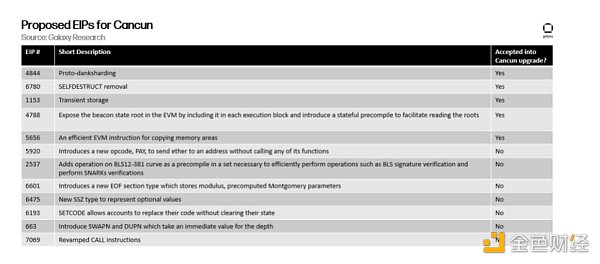
EIP 4844 emphasizes the idea of achieving long-term scalability through modularity, even though rollup technology has only just emerged. Based on ongoing research and the emergence of new technologies, modular blockchain design may undergo significant changes over the next few years. As mentioned above, EIP 4844 is a pioneer in achieving full danksharding, which Ethereum needs to compete as a DA layer with highly optimized DA layers such as Celestia. Based on the impact of EIP 4844 on Ethereum, the time and idea of Ethereum achieving full danksharding may change.
4 , Conclusion
EIP 4844 is not a game-changer for Ethereum’s scalability, as it does not lower the cost for end-users of Ethereum. Proto-danksharding lowers the cost of rollups and mainly benefits rollup users and operators. EIP 4844 sets Ethereum on a meaningful path of expansion through modularity and offloading transaction execution activities to other protocols. The benefits of proto-danksharding will be primarily identified by paying rollup sequencers for Ethereum block space. The secondary impact of proto-danksharding will be that over time, end-users and dapp developers will eventually migrate from Ethereum to trade on rollup.
Since 2022, rollup transaction activity has increased and costs have decreased. Additionally, there are some breakthrough innovations that have added confidence among Ethereum core developers and other Ethereum stakeholders in rollup as the future technology for scalable blockchain design. However, in the near future, rollup is unlikely to realize its full potential, or be ready for mass adoption, and certainly won’t launch EIP 4844 in Q3 or Q4 2023. Proto-danksharding will not impact or lower Ethereum’s costs unless transaction activity is meaningfully migrated to rollup after EIP 4844. Ethereum end-users will still suffer from the same high-cost fluctuations and network congestion unless they submit transactions through rollup sequencers, which are typically centralized and operated by single entities.
Proto-danksharding is not a panacea for Ethereum’s scalability issues, but rather the first step towards transforming Ethereum into a modular blockchain, with modular blockchains primarily supported via L2 rollups for transaction execution. EIP 4844 lays the groundwork for achieving full danksharding in the future and using polynomial commitments in DAS. In many ways, EIP 4844 is a vote of confidence in the modular blockchain theory and will encourage further rollup experimentation on Ethereum. Modularization as a solution for scaling blockchains fundamentally redefines Ethereum’s core functionality, transitioning from a general-purpose blockchain serving end-users and dapp developers to a DA layer serving sorters.
We will continue to update Blocking; if you have any questions or suggestions, please contact us!
Was this article helpful?
93 out of 132 found this helpful
Related articles
- Uniswap V4 Upgrade Analysis: Four New Features Leading DeFi Innovation
- As the ZK Rollup track becomes increasingly crowded, what are the first-mover advantages of zkSync Era?
- Lens Protocol: Introducing Lens Improvement Proposals (LIPs), Analyzing the First Three Proposals Launched Today
- SEC’s encryption regulation B-side: The Fantastic Story of Prometheus Exchange
- 20,000-word explanation of the RWA tokenization track: the next wave of the crypto narrative?
- Looking back on the innovation path of DeFi, how did Uniswap evolve from a founder to a culmination?
- Ordinals protocol has been updated to version 0.6.2, which supports recursive inscriptions and brings randomness to inscriptions.






